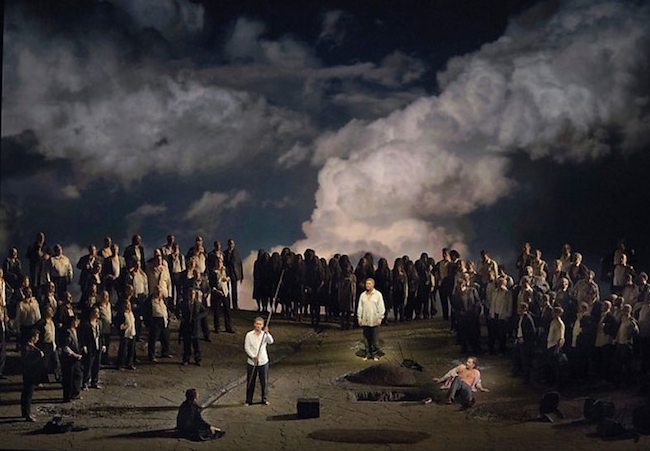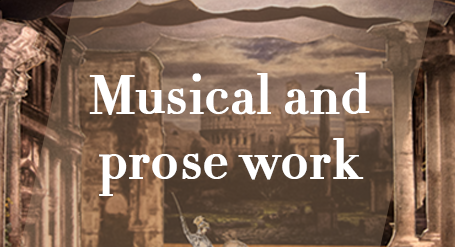
The musical work of Richard Wagner is composed of operas or “musical dramas” ranging from “Fairies” (Die Feen) to “Parsifal”. A detailed presentation of each of these major works is associated here with a set of thematic articles, placing them not only in the context of his personal life but also in his social, economic and cultural context. This section also includes all the musical works (excluding opera) and his literary work.
PARSIFAL, WWV111
Parsifal, WWV111
In short
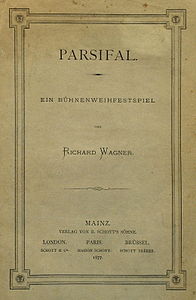 Parsifal (« Sacred scenic festival » according to the designation given by Richard Wagner) is the ultimate musical drama of the composer. Composed specifically for the Bayreuth Festival where it was produced during its second edition on 26 July, 1882, the work – exclusively performed within its walls for a while- remains the prerogative of the Festival where it is performed almost every year.
Parsifal (« Sacred scenic festival » according to the designation given by Richard Wagner) is the ultimate musical drama of the composer. Composed specifically for the Bayreuth Festival where it was produced during its second edition on 26 July, 1882, the work – exclusively performed within its walls for a while- remains the prerogative of the Festival where it is performed almost every year.
Ambiguous work – opera? oratorio? or even a mass? – mixing with abundance symbolism and spirituality, the Swan Song of the master of Bayreuth is also one of the longest works of the lyrical repertoire, its duration, according to the conductors, sometimes going up to nearly five hours of music.
From his earliest years, Richard Wagner was interested in medieval legends: the ones from Tannhäuser and Lohengrin first, then very quickly he was fascinated by the quest of the knight in search of the Grail. During the summer of 1845, while residing with his wife Minna in Marienbad, the composer discovered the epic by Wolfram von Eschenbach, Parzival, in the adaptations by San Marte and Simrock and the idea of a musical drama began to sprout. However, Wagner abandoned the project for the benefit of other more popular, less mystical ones , and it was with Tristan and Isolde that the idea came back to his mind. At the moment when Tristan, in act III of the work, was dying, Wagner even considered for a while to make Parsifal appear in search of the Grail as the figure of a quest towards the absolute: Isolde, the Grail, whatever the nature of this quest … The idea was finally abandoned.
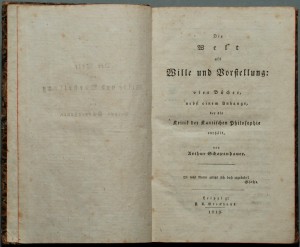 The work of Arthur Schopenhauer, and more specifically The World as Will and Representation, influenced Richard Wagner in several of his works: Tristan and Isolde of course, but also a Buddhist drama, The Victors, an apologia for supreme renunciation. The work did not see the light of day, but the idea of quest, compassion and renunciation found its way of expression and gave rise to Parsifal. If Tristan and Isolde, then The Master-Singers of Nuremberg and finally (and especially) the epic The Ring haunted the composer during the years 1858 to 1876, he never really gave up his incursion into the Kingdom of the Grail, as well as his study – a very personal one – of the medieval chanson de geste, to which he gave a new dimension, thanks to his reading of modern philosophy books.
The work of Arthur Schopenhauer, and more specifically The World as Will and Representation, influenced Richard Wagner in several of his works: Tristan and Isolde of course, but also a Buddhist drama, The Victors, an apologia for supreme renunciation. The work did not see the light of day, but the idea of quest, compassion and renunciation found its way of expression and gave rise to Parsifal. If Tristan and Isolde, then The Master-Singers of Nuremberg and finally (and especially) the epic The Ring haunted the composer during the years 1858 to 1876, he never really gave up his incursion into the Kingdom of the Grail, as well as his study – a very personal one – of the medieval chanson de geste, to which he gave a new dimension, thanks to his reading of modern philosophy books.
After having revisited and devoured the saga of the Nibelungs and given the world The Ring, and while the same Ring was performed throughout Europe thanks to the undertaking of Angelo Neumann and his Richard Wagner Traveling Theater, the composer went forward, always forward. Since 25 January, 1877, so less than six months after the production of the Ring in Bayreuth, Parsifal was put back on the skein of the composer.
Five years later, almost to the day, on 13 January, 1882, the score was completed. In Palermo. As it was under the sun of Italy that the inspiration finally came to Wagner: when he visited the Siena Cathedral, in the company of his friend the painter Paul von Joukowsky, in January 1880, the majesty of the place and its dome inspired him with the solemnity of the temple of the Holy Grail.
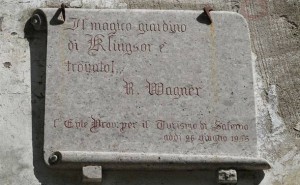 Later, while visiting this time the gardens of Palazzo Rufolo, near Ravello, it was the enchanting accents of the fairy garden of Klingsor and his daughters-flowers that appeared to the composer.
Later, while visiting this time the gardens of Palazzo Rufolo, near Ravello, it was the enchanting accents of the fairy garden of Klingsor and his daughters-flowers that appeared to the composer.
During this long gestation, the characters formed in the fruitful spirit of the composer and the music, bringing to its peak the system of leitmotifs initiated in The Ring, found its absolute completion. It was the very meticulous Engelbert Humperdinck, the future composer of Hansel and Gretel and of The King’s Children, who was responsible for copying out the score.
But more than the work, it was its performance – because Wagner was sure that with these four hours and a half of music, he was bringing something decidedly new to the History of Music – that worried the composer more. In a letter dated 28 September, 1880, Wagner expressed this concern to his friend and patron King Ludwig II of Bavaria: how can it be considered that this work would be staged in conditions that would not be « worthy » to receive such a musical offering. Indeed, the two men had in the past already quarreled about the performance conditions for The Ring.
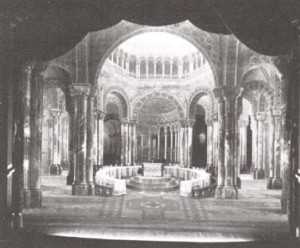 The King this time surrendered, in October 1880 and granted Wagner his request that the Bayreuth Festspielhaus would be the place reserved for the performances of what was already presented as a « sacred music festival » (Bühnenweihtfestspiel).
The King this time surrendered, in October 1880 and granted Wagner his request that the Bayreuth Festspielhaus would be the place reserved for the performances of what was already presented as a « sacred music festival » (Bühnenweihtfestspiel).
While Joukowsky was responsible for the design of the sets and costumes, the Brückner brothers were charged with their execution. But there remained a huge problem that would cause many concerns to the composer: the choice of the conductor. The position will ultimately go to Hermann Levi, despite his religion. Because Levi was Jewish and Parsifal was for some the apotheosis of the noblest sentiment of Christianity. Despite the criticisms of Cosima, who did not view very favourably this alliance between the two men, the musical understanding was perfect between the composer and the conductor, the latter at the peak of his emotions would never thank Wagner enough for having trusted him.
If the performances were planned for the summer of 1882, the rehearsals for Parsifal began in 1881, while the work was not even completed. Which did not fail to reserve some last-minute surprises. When the machinery developed by Karl Brandt for the transformation scene of the set of the first act (the so called « transformation scene ») was tested on the stage of the Festspielhaus, it did not appear as fast as would require the partition. Fair enough, Humperdinck was in charge of composing, a few days from the premiere, a few more measures to « best mesh » with the ingenious staging device!
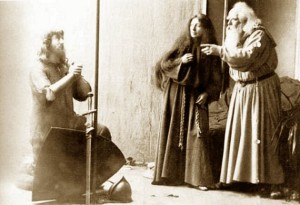 The premiere that gathered all the strengths of the Festival as well as Emil Scaria (Gurnemanz), Hermann Winkelmann (Parsifal) and Amalie Materna (Kundry), took place on 26 July, 1882 at 4 pm. It was an absolute triumph. Only one regret for Wagner: at the last moment, not being able to bear the obligations due to the protocol, King Ludwig II of Bavaria, « The Friend », finally gave up coming. However, a great novelty, at the end of the 16 performances of the « sacred scenic festival » and for the first time in its history, the Bayreuth receipts recorded a profit! Never had Wagner known… financial recognition!
The premiere that gathered all the strengths of the Festival as well as Emil Scaria (Gurnemanz), Hermann Winkelmann (Parsifal) and Amalie Materna (Kundry), took place on 26 July, 1882 at 4 pm. It was an absolute triumph. Only one regret for Wagner: at the last moment, not being able to bear the obligations due to the protocol, King Ludwig II of Bavaria, « The Friend », finally gave up coming. However, a great novelty, at the end of the 16 performances of the « sacred scenic festival » and for the first time in its history, the Bayreuth receipts recorded a profit! Never had Wagner known… financial recognition!
For a long time, Parsifal remained the exclusive domain of Bayreuth, respecting in this way the last wishes of its master (with the exception of the eight private performances given in Munich for King Ludwig II of Bavaria in 1884 and in 1885). Out of loyalty to her late husband, Cosima maintained this tradition at all costs. Could one dare to add that by making it the sole prerogative of the Festspielhaus, the « guardian of the temple » also reserved for herself the « divine » financial windfall? Therefore, there was a total embargo on the performances « beyond the Sacred Hill »! A decision entirely « Wagnerian » that did not satisfy the stages of the lyrical theatres not really inclined to respect such an injustice even if it was the will of the master himself.
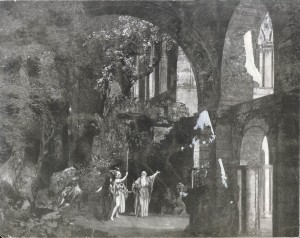 Also, on 24 December, 1903, a court ruling rendered an implacable verdict: the United States can not be concerned by this performance ban of the work. Henceforth, the Metropolitan Opera of New York decided to have the work staged thus braving the wrath of the Wagner widow: the singers who had participated in this production – mostly emanating from the Bayreuth seraglio itself – were banned from the stage of the Festspielhaus.
Also, on 24 December, 1903, a court ruling rendered an implacable verdict: the United States can not be concerned by this performance ban of the work. Henceforth, the Metropolitan Opera of New York decided to have the work staged thus braving the wrath of the Wagner widow: the singers who had participated in this production – mostly emanating from the Bayreuth seraglio itself – were banned from the stage of the Festspielhaus.
Once the Bayreuth monopoly ended, on 1 January, 1914, the lyrical theatres of Europe also took hold of the work. The Liceu Theatre of Barcelona even began a performance on 31 December, 1913 at 10.30 pm, that is to say 1h30 before 1 January, 1914, taking advantage of the time difference that existed at that time between Bayreuth and the Catalan city.
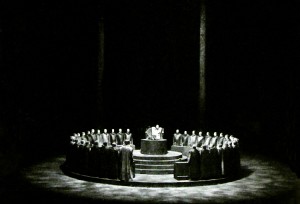
Parsifal is, with The Ring, one of the most regularly staged works of the Festspielhaus since its creation in 1882. Among the most notable productions is the post-war reopening of “New Bayreuth” in 1951 , staged by Wieland Wagner and under the direction of Hans Knappertsbusch. For the record, the conductor felt distraught at the abstraction that the grandson of Wagner offered to the public of the Festival. The absence of the appearance of the dove on the head of Parsifal in the end removed all lyricism to its conduction. Not wanting to give up anything in his quest to purify the sets and accessories, the malicious Wieland reinstated a dove that a chain brought down from the hangers of the Festspielhaus. Sufficiently long for the conductor to see it and thus be « inspired » … not enough however to be seen by the spectators!
Today, Parsifal has become one of the central works of the main lyric stages, from Met to Tokyo.
NC
If you wish to share further information about this article, please feel free to contact us !
